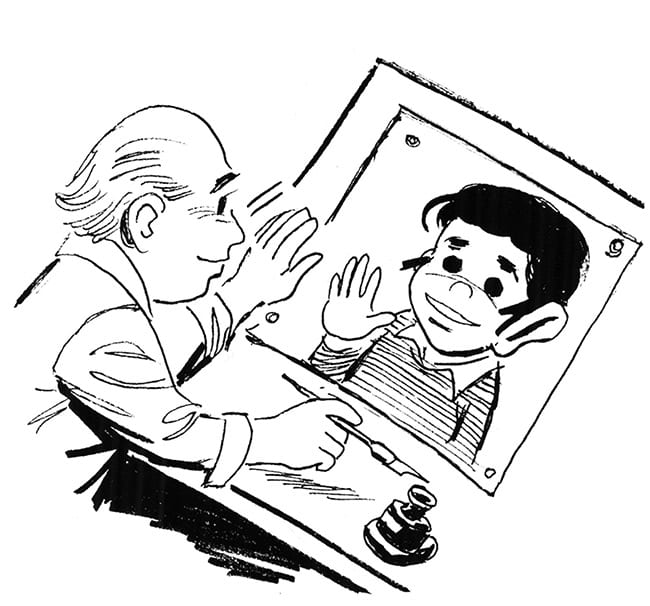R.C. Harvey is here today with an obituary for Roy Doty, grand old man of the NCS. Here is how Harvey begins:
Roy Doty’s line is immaculate, naked and unadorned and therefore vulnerable. With a more complex line—one that waxes and wanes with great flexibility, say—little mistakes in the drawing are overlooked, ignored amid the flash and filagree of virtuoso linear flourishes. But with a “clear line,” there’s no room for mistakes. A clean, uncluttered line is unforgiving: every tiny flaw in composition or anatomy leaps out, shrieking for attention. But the pictures Roy Doty drew are silent and well-behaved. No shrieks. Just sheer unadulterated competence.
Doty, too, was unadulterated. But not silent. In declining health since suffering a stroke late last year, he died March 18, defiant, I like to think, to the very end.
He was 93. He always scoffed at the idea of retirement. “Retire from what?” he’d say. “You have to have a job first.”
He was a proud freelancer and had been all his working life. “I have an unblemished work record,” he’d say. “I have never held a job in my life, and I intend to keep it that way.” He was a cartoonist, artist and illustrator, creating humorous pictures in books and magazines, packaging, advertising, comic strips and television.
We also have Rob Clough's review of the most recent Eric Haven book, UR:
Ur has two meanings: it is a reference to an ancient Sumerian city, and also a word indicating that something is the most original, basic or primal form of something. In Eric Haven's comic UR, he gets at the dark and primal portions of his own imagination, as attractive bartenders are actually reptilian monsters and the world can crack in half at any time. It's also a reference to the sort of comics that clearly influence him, especially Marvel comics from the 1960s. It's not so much the stories that seem to interest him but rather the trappings: the weirdness, the emotional exaggerations, and the frequent stiffness of the art. His goal is not to imitate it nor even parody it, but to celebrate it in the most absurd and strange manner possible.
Above all else, and despite the fact that it's listed as "Mature/Adventure/Superhero/Sci-Fi/Fantasy/Horror" on the back cover, UR is at its heart humorous. Darkly humorous at times, to be sure, but there are dozens of superb punchlines to be found here. Take "The Equestrian", for example. This is a plotless story about the titular character (a ghoulish, near-skeletal jockey) intent on destruction for its own sake. First she uses her riding crop to smash a lighthouse, causing a ship to run aground. Then she takes out an airplane's engine, causing it to crash. Then she strikes the ground twice and destroys the earth. The end. Haven perfectly gets down that EC Comics-style appearance minus the explanatory narrative and builds the story up in a rhythm that escalates the action until it reaches an over-the-top ending. It's not funny, per se, but it has the rhythm of a joke and embraces its own silliness.
Meanwhile, elsewhere:
—Reviews & Commentary. Dorian Lynskey has an article at The Guardian about recent more woman-friendly titles (and recent controversies) at Marvel and DC. It upholds the proud tradition of headlining all articles on comics with the word "Kapow," and is obviously very superhero-centric, but is otherwise a fairly solid piece.
—Interviews. At The Beat, Pádraig Ó Méalóid has begun another one of his regular, highly readable, multi-part interviews with Alan Moore.
—Crowdfunding. Julia Wertz is looking for funding for a followup to Drinking at the Movies, but is doing it on her own site rather than through Kickstarter or Patreon. (She also has a three-page story up on The New Yorker's website, about the lost decades when pinball was an illegal activity in NYC.)
I don't think we've previously mentioned that Michael DeForge is on Patreon now, but if we have, it's still worth repeating.
—Funnies. Ger Apeldoorn has posted some Roy Doty Laugh-In strips.






